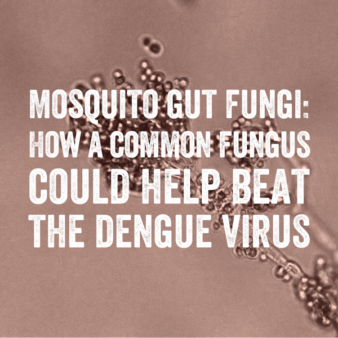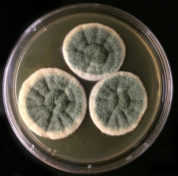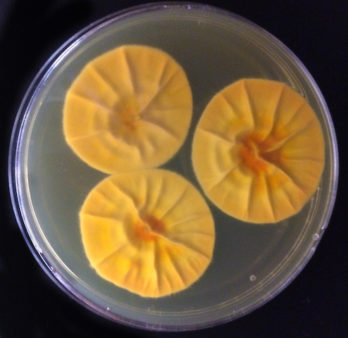- by Alison
Mosquito gut fungi: How a common fungus could help us beat the dengue virus

We recently looked at how environmental factors such as climate change can affect how the dengue virus thrives in the Aedes aegypti mosquito and the mosquito’s ability to transmit the disease. Researchers at Johns Hopkins University Bloomberg School of Public Health in Maryland in the U.S. have found another environmental factor that can influence the virus within the mosquito: a common species of fungus. We spoke with Professor George Dimopoulos about the Talaromyces fungus that lives in the Aedes aegypti mosquitoes’ gut. He explained how it makes the insects more susceptible to dengue infection – and could potentially improve their ability to transmit the disease.
“This common fungus makes the mosquito more susceptible to infection by the dengue virus and could, potentially, also influence the mosquito’s ability to transmit the disease,” says George Dimopoulos, Ph.D., Professor in the Bloomberg School’s Department of Molecular Microbiology and Immunology.
Fungi living in mosquitoes
Professor Dimopoulos and his team have known for some time that mosquito microbiota – the bacteria and fungi that live in mosquitoes – influence how susceptible the mosquito is to infection from a pathogen such as the dengue virus. Laboratory studies had also led them to suspect that microbiota could influence how well a mosquito could transmit that pathogen.

The Talaromyces fungus (top) growing in the lab. Image courtesy of Johns Hopkins University Bloomberg School of Public Health
“We needed to go out in the field and see what kind of bacteria and fungi are found naturally in wild mosquitoes and whether they influence mosquito’s ability to get infected with, for example, the malaria parasite or the dengue virus,” says Professor Dimopoulos.
Read the latest update on the dengue fever vaccine pipeline
The team set out on a field trip to bring wild mosquitoes back to the lab: Anopheles mosquitoes that transmit malaria along with Aedes aegypti. They fed fungi to the wild mosquitoes. “We noticed that certain fungi, when fed to a mosquito, would make it more susceptible to malaria or dengue fever infection,” says Professor Dimopoulos. “A penicillium fungus made it more susceptible to malaria while a Talaromyces fungus made it more susceptible to dengue.”
So, what was going on?
The team wanted to find out whether the mosquito’s gut needed the whole Talaromyces fungus or something the fungus was producing and secreting to make it more susceptible. They made a culture of the fungus and filtered it to leave the molecules secreted by the fungus. “When we fed the mosquitoes on this filtrate, they still became more susceptible to the dengue virus infection,” says Professor Dimopoulos.
They ran another experiment. It proved that the fungus was changing something in the mosquito. “The fungus wasn’t making the virus replicate quicker or anything like that, it was just making the mosquito more susceptible to infection,” says Professor Dimopoulos.
Digesting the virus?
By comparing gene expression (the process by that converts DNA instructions into something the body uses) between mosquitoes exposed to this fungus filtrate with those not, the team found that many of the digestive enzymes in the mosquito’s gut were produced in smaller quantities when this filtrate was present.
“The fungus seemed to be influencing the mosquitoes’ digestive system in some way,” says Professor Dimopoulos. “It was slightly impairing the mosquito’s ability to digest the blood. We also noticed that the mosquitoes fed on the filtrate did not produce as many eggs. Egg production is highly dependent on blood digestion.”
The team then turned their focus to trypsins, enzymes that digest proteins. When they removed some trypsins from a mosquito’s gut and then infected the mosquito with the dengue virus, the mosquito becomes more susceptible to dengue virus infection.

The Talaromyces fungus (bottom) growing in the lab. Image courtesy of Johns Hopkins University Bloomberg School of Public Health
“We think that these particular trypsins are, in some way, impairing the virus’ ability to infect the gut,” says Professor Dimopoulos. “They could be digesting something on the surface of the virus, or there could be some other mechanism. It’s not entirely clear.”
More studies needed
While all these experiments took place in the lab, the Talaromyces fungus occurs naturally – and indeed is commonly found – in rural areas in most South-Eastern Asian countries.
“We know these fungi are common in nature and wild mosquitoes are exposed to them,” says Professor Dimopoulos, “but it is very difficult to determine whether that natural exposure to the fungi in the field influences mosquitoes’ susceptibility to the dengue virus and their ability to transmit the virus.”
Read how Wolbachia-infected mosquitoes are reducing dengue outbreaks
Understanding that influence may one day part of a larger study to explore the impact of various microbiota on mosquitoes in the wild. If a correlation could be proven, it would suggest that these fungi do play a role in regulating Aedes aegypti mosquitoes’ susceptibility to the dengue virus and perhaps also transmission.
If a link could one day be proven, the knowledge gained could be used to develop a new tool to fight the dengue virus, something that would prevent dengue from spreading. If it could be shown that removing the fungi in the field would have an impact on dengue transmission, for instance, we could one day be using a fungicide to kill off Talaromyces as well as – or even instead of – spraying insecticide to kill mosquitoes.
—

